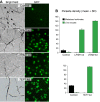Transmission blocking immunity in the malaria non-vector mosquito Anopheles quadriannulatus species A
- PMID: 18497855
- PMCID: PMC2374904
- DOI: 10.1371/journal.ppat.1000070
Transmission blocking immunity in the malaria non-vector mosquito Anopheles quadriannulatus species A
Abstract
Despite being phylogenetically very close to Anopheles gambiae, the major mosquito vector of human malaria in Africa, Anopheles quadriannulatus is thought to be a non-vector. Understanding the difference between vector and non-vector mosquitoes can facilitate development of novel malaria control strategies. We demonstrate that An. quadriannulatus is largely resistant to infections by the human parasite Plasmodium falciparum, as well as by the rodent parasite Plasmodium berghei. By using genetics and reverse genetics, we show that resistance is controlled by quantitative heritable traits and manifested by lysis or melanization of ookinetes in the mosquito midgut, as well as by killing of parasites at subsequent stages of their development in the mosquito. Genes encoding two leucine-rich repeat proteins, LRIM1 and LRIM2, and the thioester-containing protein, TEP1, are identified as essential in these immune reactions. Their silencing completely abolishes P. berghei melanization and dramatically increases the number of oocysts, thus transforming An. quadriannulatus into a highly permissive parasite host. We hypothesize that the mosquito immune system is an important cause of natural refractoriness to malaria and that utilization of this innate capacity of mosquitoes could lead to new methods to control transmission of the disease.
Conflict of interest statement
The authors have declared that no competing interests exist.
Figures



References
-
- Coluzzi M, Sabatini A, della Torre A, Di Deco MA, Petrarca V. A polytene chromosome analysis of the Anopheles gambiae species complex. Science. 2002;298:1415–1418. - PubMed
-
- Hunt RH, Coetzee M, Fettene M. The Anopheles gambiae complex: a new species from Ethiopia. Trans R Soc Trop Med Hyg. 1998;92:231–235. - PubMed
-
- White GB. Anopheles gambiae complex and disease transmission in Africa. Trans R Soc Trop Med Hyg. 1974;68:278–301. - PubMed
-
- Coetzee M, Craig M, le Sueur D. Distribution of African malaria mosquitoes belonging to the Anopheles gambiae complex. Parasitol Today. 2000;16:74–77. - PubMed
-
- Davidson G. The Five Mating-Types in the Anopheles Gambiae Complex. Riv Malariol. 1964;43:167–183. - PubMed
Publication types
MeSH terms
Substances
Grants and funding
LinkOut - more resources
Full Text Sources
Other Literature Sources
Medical
Research Materials

